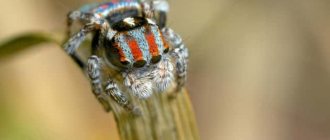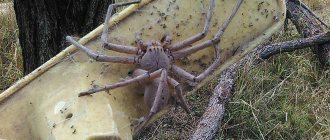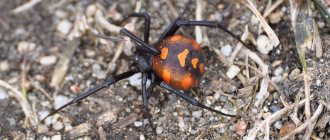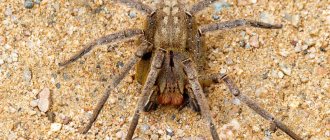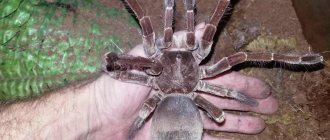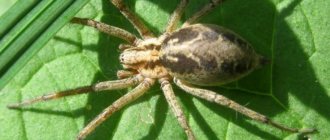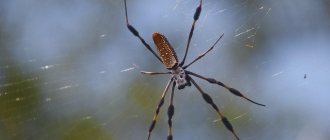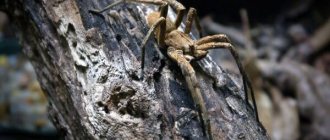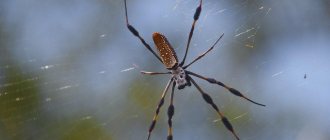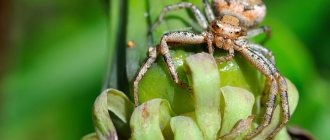- Wild animals
- >>
- Arachnids
The six-eyed sand spider is a medium-sized spider of deserts and other sandy environments in southern Africa. It is a member of the araneomorpha spider family, and close relatives of this spider are sometimes found in both Africa and South America. Its closest relatives are the recluse spiders, which are found throughout the world.
Six-eyed sand spider (Latin: Sicarius hahni)
The six-eyed sand spider is ranked among the top five most dangerous spiders in the world. The toxicity of its venom is in no way inferior to the toxicity of the venom of spiders that are leaders on this list (for example, the Brazilian wandering spider, the leukopachine funnel web spider, shadow spiders).
Six-eyed sand spider (lat. Sicarius hahni) (eng. Six-eyed sand spider). Photo by M.Heule
The six-eyed sand spider belongs to the Sicariidae family and is a close relative of the hermit spiders of the genus Loxosceles.
The habitat of these spiders is sandy areas in southern Africa. Other species from the same family have also been found in South America. They live among sand dunes, hiding under stones, snags, between tree roots, and masterfully bury themselves in the sand.
These spiders are classified as “living fossils” because they inhabited these continents even before the division of the ancient supercontinent Gondwana (which included the territories of modern Africa, South America, Australia and Antarctica), which occurred about 100 million years ago. There are 21 species in the genus Sicarius, most of which are distributed in Africa (Western Cape and Namibia). An interesting fact is that spiders living on the African continent have stronger poison than their South American counterparts.
The six-eyed sand spider is medium in size. The length of its body reaches 8-15 millimeters, and if measured with the span of its legs, then about 50 millimeters. Six eyes. Depending on their habitat, these spiders may be reddish-brown or yellowish in color. Thanks to its flattened body and slightly curved legs, the six-eyed spider looks somewhat like a crab. For which it received another name - the crab spider.
These spiders are very “shy” and try to avoid meeting people. Therefore, the likelihood of meeting them and being bitten is extremely low. There are only 2 known cases in the world where people died from the bite of this spider.
Their venom contains cryotoxin, which is considered one of the most powerful toxins ever discovered in living things. It completely destroys tissue cells, causing ruptures in the walls of blood vessels, which leads to numerous and serious internal bleeding. Unfortunately, an antidote for this poison has not yet been created. Scientists still cannot fully understand how this toxin does not destroy the cells of the internal organs of the spider itself. It is believed that it (the toxin) acts like sulfuric acid.
Sicarius hahni perfectly senses the vibration created by any creature, even the smallest, and when it passes very close, the spider quickly attacks. He immediately injects poison into his victim and waits for it to take effect. You don't have to wait long. The victim dies almost immediately.
Photo by M. Heule
They lay their eggs in a cup-shaped bag woven from adhesive thread and sand particles, which they then bury thoroughly. Egg development occurs over a fairly long period of time.
Photo by M. Heule
Photo by M. Heule
This spider is a vivid example of how to survive under unfavorable living conditions. Well-fed, these spiders can live without food and water for about a year. Their total lifespan can reach 15 years, which is unusual, since most related spiders live no more than 3 years.
Photo by M. Heule
Photo by M. Heule
Biological characteristics
In official biological language, argiope belongs to the family of orb-weaving spiders. This family is characterized by the production of a large circular catch net with a pronounced spiral stabilimentum in the center. This section of the web is clearly visible in ultraviolet rays, which are distinguishable by many insects, and therefore the stablimentum is so attractive to various insects and beetles.
Appearance
According to the description, the Argiope spider really looks like a wasp or a zebra. The body of the arthropod clearly shows an alternation of black and yellow stripes, however, this is characteristic only of females. Males of this species are small and inconspicuous.
Argiope Brünnich spiders exhibit pronounced dimorphism. The female has a body size of 15-30 millimeters in length, while the male Argiope barely reaches half a centimeter.
Spreading
This striped black and yellow spider mainly inhabits the middle and southern regions of Europe and Russia. But recently, thanks to climate warming, argiope has begun to be found in the northern regions. There is information that our spider was seen in the Moscow and Nizhny Novgorod regions, and even further north.
Lifestyle
The usual colony of Argiope settles in forests or meadows. where there is a massive number of potential casualties. The number of one settlement is usually about two dozen spiders.
A yellow striped spider weaves its webs in the twilight evening. He spends no more than one hour making his trap. After the web is woven, its owner is placed in the center of the network and, taking the shape of the letter "X", awaits the victim.
It should be noted that the Argiope catching net is very beautiful; it is distinguished by the presence of a pronounced circular shape and small cells, through which even the smallest mosquito cannot break through.
Nutrition
The zebra argiope spider feeds on the insects that fall into its web. These are mainly numerous Orthoptera, although various flies or mosquitoes often find themselves in the web. The spiders inject poison into them and entwine them with cobwebs, then they suck the juices from the victim’s body, which has begun to dissolve.
Reproduction
The female reaches the age of sexual reproduction after the last molt of her development. During mating, the female wraps a web around the male, and if he fails to get out, then his fate is unenviable - he will certainly be eaten.
And the female will then weave a large cocoon, into which she will place her numerous eggs, which she guards with the care of a loving mother.
At the beginning of autumn, the spiderlings emerge from the cocoon, and, being attached to the webs, are carried by the wind around the area, thus creating new colonies of spiders.
In other cases, the female can lay eggs, and there are up to a hundred of them in one cocoon, in late autumn, and the young spiders hatch and settle with the arrival of spring. The female herself does not overwinter, but, having laid eggs, dies.
Six-eyed sand spider
The six-eyed sand spider (lat. Sicarius hahni) does not like to weave webs. Unlike its arachnid relatives, it prefers to attack its prey from an ambush: quickly moving with its long legs, the spider almost completely buries itself in the sand.
The tiny hairs that cover its entire body, to which small grains of sand stick, also help to camouflage thoroughly, making it practically invisible.
The six-eyed sand spider can remain in this position for a very long time, waiting for small insects or scorpions, which make up its diet. Having noticed prey, the arthropod predator attacks with lightning speed, injecting deadly poison into the unfortunate creature, and waits for it to take effect.
Literally after a few seconds the insect dies and the spider slowly starts eating. He has nowhere to rush - having had a good meal, he can do without water and food for a whole year.
Perhaps this is why the lifespan of the sand spider sometimes reaches 15 years, which is not entirely usual, because most species close to it barely live to be three.
And the living conditions he chose for himself were not at all heavenly. The habitat of the six-eyed sand spider is lifeless sandy areas in southern Africa and South America.
Such a huge territorial gap occurred because six-eyed spiders inhabited these continents even before the division of ancient Gondwana, which, according to experts, occurred more than 100 million years ago.
These deadly insects hide among sand dunes, under snags and stones, and between tree roots. Fortunately for people, sand spiders are very shy and try to avoid encounters with them.
Meanwhile, such unplanned “dates” can end very badly, because these insects are among the five most dangerous spiders in the world. Their poison is so toxic that scientists still cannot understand how it does not kill its owner.
The venom of the six-eyed sand spider contains one of the most powerful toxins ever found in living things. Cryotoxin causes severe ruptures in the walls of blood vessels, which in turn leads to extensive internal bleeding.
To date, it has not been possible to create an antidote, but, despite this disappointing fact, there are only two known cases where people died from the bites of six-eyed spiders. Apparently these arthropods are too rare to be of serious concern.
Sak
What are the most dangerous spiders in tenth place in the presented ranking? These arthropods are called golden or golden ones. We are talking about yellow saka spiders, which live mainly in Europe. This small (up to 1 cm in length) arthropod builds itself a bag-like shelter. Sometimes sakis simply sit out inside their house. The bites of these spiders are clinically dangerous and cause extensive tissue necrosis. However, fortunately, golden sakis are not at all aggressive. They can attack people only when there is a feeling of danger.
Origin of the species and description
Photo: Six-eyed sand spider
The six-eyed sand spider is also known as the six-eyed crab spider due to its flattened stance and laterid legs. It is believed that the venom from the bite of these spiders is the most dangerous among all spiders. The six-eyed sand spider is a living fossil that predates the Gondwanaland drift some 100 million years ago and is also found in South America. There are 6 species distributed in the Western Cape, Namibia and Northern Province.
- in sand;
- on sand dunes;
- under rocks and rocky ledges;
- in close proximity to ant pits.
Video: Six-eyed sand spider
The six-eyed sand spider, native to the Northern Cape and Namibia, may be the deadliest spider in the world. Fortunately, due to its habitat, it is rare and does not seem to want to bite. However, this spider should not be handled as there is no effective treatment against its venom.
Fun Fact: The scientific name for the six-eyed sand spider family is Sicarius, which means "killer" and "sica" means curved dagger.
The genus to which the six-eyed sand spider belongs was first created in 1878 by Friedrich Karsch as Hexomma, with a single species, Hexomma hahni. However, by 1879, Karsh realized that the name had already been used in 1877 for a janitor species, so he published a replacement name, Hexophthalma.
In 1893, Eugene Simon transferred Hexophthalma hahni to the genus Sicarius, and Hexophthalma fell into disuse until a phylogenetic study in 2022 showed that African species of Sicarius, including the six-eyed sand spider, were distinct from each other, and revived the genus Hexophthalma for them. Two new species were added to the genus in 2022, and one previously accepted species, Hexophthalma testacea, is synonymized with the six-eyed sand spider. The number of species is expected to increase with further research.
Horrible in person
But almost cute on the inside. All tarantulas are poisonous, but their venom is low-toxic and the bite of these spiders is not dangerous to humans. Unless the victim has an allergic reaction to spider venom. But in this case, the size of the spider is not so important.
If you arrange spiders in descending order, you will get something like this rating:
- Theraphosa blondi (Goliath species).
- Heteropoda maxima (species of Heteropoda maxima).
- Acanthoscurria (genus of spiders Acanthoscurria).
- Nhandu coloratovillosus (Coloratovillosus species).
- Nhandu tripepii (Nandu tripepii species).
- Brachypelma smithi (Species of Brachypelma smithi).
- Lampropelma nigerrimum (Lampropelma nigerrimum species).
- Lampropelma nigerrimum arboricola (species Lampropelma nigerrimum arboricola).
- Aphonopelma seemanni (species of Aphonopelma zemanni).
- Avicularia purpurea (Species of Avicularia purpura).
Goliath
The female's body grows up to 10 cm. Males are smaller - 8.5 cm. The paw span can be 28 cm. The color is dark brown. The body is completely covered with short reddish-brown bristles. Lives in the tropical zone of South America.
The most terrible spidersHeteropoda maxima
It rivals Goliath in size, although the female’s body length is only 4.6 cm, the male’s is 3 cm. But the limb span is 25-30 cm. The species was recently discovered in Laos. The color of spiders is brownish-yellow. There are no gender differences in color. Presumably the species lives in caves. The toxicity level of the venom and the strength of the bite are unknown. But this tarantula looks really creepy. Especially because of the large chelicerae.
Acantoscuria
This is a genus of large spiders. The paw span of the smallest species is 12 cm. The largest is 22 cm. The color is dark brown with a light border along the cephalothorax and light stripes on the paws. Outwardly it resembles the South Russian tarantula, but has a more attractive appearance.
Nervous character. If disturbed, it may bite. Considering the easily excitable nervous system of arthropods and their number in tarantula lovers, the venom of representatives of this genus is low-toxic.
Rhea coloratovillosus
The body and paws of the animal are covered with thick and long reddish bristles. The length of the female is up to 9 cm. The paw span is up to 18 cm. A native of Brazil. Stubble that easily falls out poses a danger to humans.
Rhea thriperia
A very fluffy arthropod whose pink or red bristles perform a protective function. Therefore, the spider itself does not exchange bites and is valued for its docile disposition. The paw span is up to 18 cm. Females grow up to 8 cm, males up to 5 cm. Country of origin is Brazil.
The most terrible spiders
Brachypelma smithy
The body dimensions are close to Goliath: up to 9 cm. The paw span is up to 17 cm. The tarantula has a very beautiful coloring: a dark background with red spots on the paws. With age, the contrast intensifies.
It uses bristles as protection, since the poison is slightly toxic. The bite is not dangerous to humans. In addition, the animal has a very calm disposition.
Lampropelma nigerrium
The body size of adult individuals is 6-8 cm. The paw span is 17-19 cm. In particularly large specimens, the leg span can be 20 cm. The color of females is jet black, males are ashen, with a striped pattern on the abdomen.
Lampropelma nigerrium arboricola
Body size up to 8 cm, paw span up to 18 cm. Females are black, males are ash-yellow. Animals are burrowers. They hunt at night.
The character is similar to its brother in its genus: an aggressive, fast arthropod with strong poison. In the absence of shelter, it is prone to bites. The poison can cause several unpleasant days for a person.
Afonopelma zemanni
The paw span is up to 14 cm. The color is black or dark brown with light stripes on the paws. They are nocturnal. Fast and active only at night. The rest of the time they prefer to sit in shelters, as they do not like sunlight.
The poison is weak. The bite is similar in strength to that of a wasp. When a person is bitten, local irritation and swelling go away on their own after 2-3 days.
The most terrible spiders
Avicularia purpura
An inhabitant of Ecuador in nature builds nests in hollows. Likes to use voids in human habitation for nesting. Completely covered with thick black bristles that glow purple-blue in the sun. Grows up to 6 cm. Leg span up to 14 cm.
Protection is provided by irritating bristles, since the venom is weak and the bite is not dangerous to humans.
Although photos of scary tarantula spiders make an impression, it is not these giants that are truly dangerous, but modest little spiders. Often these spiders have an inconspicuous camouflage color.
Appearance and features
Photo: What a six-eyed sand spider looks like
The six-eyed sand spider has 6 eyes arranged in 3 dyads that are widely spaced in a curved row. The cuticle is leathery with curved bristles and is usually burgundy or yellow in color. The six-eyed sand spider is covered in small hairs called setae (a coarse hair, seta, bristle-like appendage, or part of an organism) that serve to hold sand particles. This provides effective camouflage even when the spider is not buried.
The six-eyed sand spider has a body length of up to 15 millimeters, and the width of the legs is about 50 millimeters. Most species are reddish-brown or yellow in color without any distinct patterns. Six-eyed sand spiders often camouflage themselves with particles of sand sandwiched between their body hairs to blend into the background of their specific habitat. Six-eyed sand spiders are shy and secretive, but will bite if accidentally contacted.
Fun fact: Six-eyed sand spiders can live up to 15 years, four times longer than the average spider.
These free-living spiders are terrestrial animals and have a uniform yellowish-brown overall color. Six-eyed sand spiders have a dusty, sandy appearance and take on the coloration of the ground they live on.
Where does the six-eyed sand spider live?
Photo: Six-eyed sand spider in Africa
Based on evolutionary evidence, relatives of six-eyed sand spiders are thought to have originated in western Gondwana, which is one of two supercontinents that existed about 500 million years ago. Because they colonized this land so long ago, these spiders are sometimes called "living fossils." The current distribution of this spider family is mainly found in Africa and Latin America. This divergence is thought to have occurred when the supercontinents diverged approximately 100 million years ago, separating Africa from the Americas.
The six-eyed sand spider can be found in sandy areas of South and Central America. This spider lives in the desert and hunts in ambush. Unlike most hunters who wait for prey in ambush, the six-eyed sand spider does not dig a hole. Instead, it lurks just below the surface of the sand. It has a poison that is potentially fatal and can damage the heart, kidneys, liver and arteries, and cause flesh to rot.
These spiders do not make webs, but instead lie half-buried in the sand, waiting for prey to pass by. They are widespread, but are more common in dry areas. The six-eyed sand spider has a poor sense of direction, unlike other spider species.
Now you know where the six-eyed sand spider is found. Let's see what he eats.
Safe types
It should be noted right away that absolutely all spiders are poisonous, but only a few will be dangerous to human health - arthropods with highly toxic poison. In this chapter we will look at those whose venom is lethal exclusively to insects.
House spiders
These are perhaps the most famous and most common spiders living in Russia. They got their name because they love to be neighbors with people - they can be found in a private house, in a city apartment, and in outbuildings. This spider usually weaves a funnel-shaped web in dark corners under the ceiling or in more secluded places, for example, somewhere behind a closet. The owner himself usually sits in the center of the fishing net and patiently waits for the prey to fall into it. And as soon as the victim is in the web, the spider runs up to her with lightning speed and immediately straightens out.
You can recognize a house spider by the following signs:
- the integument is yellowish-gray or brownish-gray;
- on the back there are usually brown spots arranged in a pattern;
- the legs are dark brown, their length is approximately twice as long as the body;
- The size of females is about 12 mm, the male is no more than 10 mm.
Knitting spiders
There are quite a few species of crocheters, and these spiders are found in Russia more often than others. They are distributed throughout the country and live exclusively in natural conditions. Their trapping nets are circular in shape and have very large meshes. Because of them, at first glance, it may seem that such a web is not suitable for hunting. However, it is not. The net is designed for a specific victim, namely long-legged mosquitoes, which are a favorite delicacy for knitters.
The knitting spider has the following description:
- elongated body;
- legs are long;
- chelicerae are covered with numerous projections;
- Females are usually about 10 mm in size, males are somewhat smaller.
What does the six-eyed sand spider eat?
Photo: Six-eyed sand spider in nature
The six-eyed sand spider does not wander around looking for prey, it simply waits for an insect or scorpion to pass by. When it does this, it grabs the prey with its front legs, kills it with poison, and eats it. Six-eyed sand spiders do not need feeding very often, and adult spiders can live for a very long time without food or water.
The six-eyed sand spider catches prey by hiding under the sand. It lifts its body, digs a hole, falls into it, and then covers itself with sand using its front paws. It catches prey with its front paws when the victim runs across the hidden spider. If a six-eyed sand spider is discovered, it will become covered in fine sand particles that adhere to the cuticle, acting as effective camouflage.
Features of character and lifestyle
Photo: Six-eyed sand spiders
Fortunately, this spider, like the recluse spider, is very shy. However, research has shown that this spider venom is the most poisonous of all spiders. There is some question regarding the danger this spider poses. Although it is very shy and unlikely to bite humans, there are few (if any) recorded human envenomations by this species.
However, research has shown that the venom is particularly potent, with a potent hemolytic effect (rupture of red blood cells and release of hemoglobin into the surrounding fluid) and a necrotic effect (random death of cells and living tissue) causing blood to leak from vessels and tissue destruction.
The bite of the six-eyed sand spider causes many problems, including:
- leaking blood vessels;
- blood thinning;
- tissue damage.
Unlike the dangerous neurotoxic spiders, there is currently no antivenom for this spider's bite, leading many to suspect that this spider's bite can be fatal. There were no confirmed human bites and only two suspected cases. However, in one of these cases, the victim lost an arm due to massive necrosis, and in another, the victim died from severe bleeding similar to the effects of a rattlesnake bite.
Fun fact: The six-eyed sand spider rarely comes into contact with humans, and even when it does, it usually never bites. Additionally, like most spiders, it does not always inject venom with every bite, and even then it does not necessarily inject large amounts.
In summary, the docile behavior and natural history of six-eyed sand spiders have resulted in very few recorded bites, so the symptoms of their bites in humans are poorly understood.
Karakurt
Karakurt, or steppe widow (lat. Latrodectus tredecimguttatus) is another representative of the genus of black widows and is even similar to a black widow, but larger in size. Unlike its predecessor, it stays away from human habitation.
Karakurt poison is very toxic and can harm even large animals. This spider is quite peaceful and will rarely attack a person first, only if he is disturbed. At the moment of the bite, a strong and burning pain is immediately felt, spreading throughout the body for 15-20 minutes, then symptoms characteristic of poisoning appear. There have been cases of death.
Social structure and reproduction
Photo: Six-eyed sand spider
Six-eyed sand spiders reproduce by laying eggs in silken bundles called egg sacs. Spiders often use complex mating rituals (especially in the visually advanced jumping spiders) to allow the male to get close enough to inseminate the female without causing a predatory response. Assuming mating initiation signals are exchanged correctly, the male spider must make a timely departure after mating to escape before the female eats him.
Like all spiders, the six-eyed sand spider is capable of producing silk from its abdominal glands. This is commonly used to create webs, such as spiders, which can be seen every day. The six-eyed sand spider does not make webs, however, it does use this unique ability to make silken bundles called egg sacs to surround its eggs.
Interesting fact: The egg sac is made up of many sand particles that are glued together using silk produced by a spider. Each of these egg sacs can hold many young eggs.
These spiders spend a surprisingly large portion of their lives in close association with sand, so it makes sense that they would end up in a world largely submerged in it. Because these spiders hide under the sand for most of their days, when the male approaches a female to mate, he does so slowly so as not to provoke a fight or flight response from the female spider.
Natural enemies of six-eyed sand spiders
Photo: What a six-eyed sand spider looks like
Six-eyed sand spiders have no natural predators. They themselves are the enemy of those who try to approach them. All members of the genus to which it belongs are capable of producing sphingomyelinase D or related proteins. It is a potent tissue-destroying substance unique to the spider family, otherwise found only in a few pathogenic bacteria.
The venom of many species of Sicariidae is highly necrotic in fact, capable of causing lesions (open wounds). Wounds take a long time to heal and may require skin grafts. If these open wounds become infected, serious consequences can occur. Rarely, the poison is carried by the bloodstream to the internal organs, causing systemic effects. Like their close relatives, the recluse spiders, the venom of the six-eyed sand spider is a powerful cytotoxin. This venom is both hemolytic and necrotic, meaning it causes leakage of blood vessels and destruction of flesh.
Most people bitten by a six-eyed sand spider simply wandered too close to its hiding place. There are ways to try to reduce the spider's damage, but there is no specific antivenom available. To avoid damage, it is best to avoid this spider completely, which should not be that difficult for most people when considering its habitat.
Population and species status
Photo: Six-eyed sand spider
More than 38,000 species of six-eyed spiders have been identified, however, due to their great ability to hide, it is believed that there are about 200,000 species. The six-eyed sand spider's natural habitat is rapidly expanding due to the spider's reluctance to stray far from home. Based on data collected by studying the various exoskeletons these spiders hid throughout their lives, individuals remain in the same location for most, if not all, of their lives.
Chinese tarantula
This spider is classified as one of the varieties of the large tarantula. The length of its body is about twenty centimeters. You can meet arthropods of this species in Vietnam and China. Due to their inherent size and ferocious appearance, locals call these spiders earth tigers.
The venom of the Chinese tarantula has been studied in laboratory conditions. Experimental results have proven that toxic substances released by these arthropods lead to the death of small mammals in fifty percent of cases.
The six-eyed sand spider leaves no chance for its prey
The six-eyed sand spider is one of the five most dangerous spider species in the world. The properties of its venom are so toxic that they leave no chance for the bitten animal or person. In terms of the degree of concentration of the poison, its deadly secretions are on a par with the poison of the black widow spider, which is more commonly known due to the memorability of its name.
The species of six-eyed sand spiders began to be studied in the middle of the 19th century thanks to the research and materials of S. Walkener, an arachnologist of French origin.
Subsequently, the study of the species was continued, and more information appeared about this valuable and dangerous species. The sand spider is classified as a member of the Sicariidae family and is related to hermit spiders of the genus Loxosceles.
Black Widow
The top 10 most dangerous spiders in the world continues with this small-sized representative of arthropods. The length of its body is only 1.5-2 centimeters. And although the females of these representatives of arthropods are twice as large as the males, they are also quite difficult to distinguish in natural conditions. Nevertheless, these are the most dangerous spiders, located almost at the top of the corresponding rating.
Is in constant “mourning”. Only sexually mature adults have red hourglass markings on their abdomen. Young spiders have a light color. Their body is sometimes white or yellowish-white. The color becomes darker only with age. The body of these spiders acquires only by the second or third month of life.
This most dangerous spider (see photo below) did not receive its “mourning” name by chance. The females of this arthropod are distinguished by cannibalism towards males.
The habitat of these spiders, as a rule, is Central Asian deserts and steppes. They are less common in the Caucasus, as well as in the Crimea.
The black widow, ranking third out of the 10 most dangerous spiders, prefers to hunt in recesses under stones, placing its snares at a small height from the ground. She also watches for victims in cracks and various openings, over squat plants and even in the thick of grape vines.
Representatives of these spiders go hunting at night. During the day, they prefer to hide in their shelters. The food for the black widow is usually insects. However, these spiders are not averse to dining on woodlice and their own relatives.
The bite of a black widow is dangerous to humans. This is especially true for older people and children. The poison, spreading throughout the body, causes severe muscle spasms. Also, after a black widow spider bite, weakness and headache, shortness of breath and increased salivation, vomiting, a feeling of anxiety and tachycardia appear. You can neutralize the poison by burning the bite site with a match. To eliminate the possibility of an allergic reaction, it is also advisable to take the victim to the hospital.
Description of the spider
Appearance
In general, it can be called six-eyed, crab spider, sand spider.
Reproduction and development
Sand spiders have sexual differences. The female bears the eggs and lays them in a cocoon cup, which she weaves from sticky spider thread with the addition of sand. She then buries the cocoon in the sand and leaves forever. Young spiders free themselves from the eggs and emerge from the cocoon after some time.
The development of spiders until the period of reproductive age lasts a long time. This is also because the total lifespan of the six-eyed sand spider is approximately 15 years, while other spiders live about three years.
Food and hunting
In order to exist and enjoy its spider life, each individual hunts small-sized insects and scorpions, which are larger and more nutritious. For a successful hunt
the spider, quickly buried in the sand, waits in the wings. Even having been partially buried, he does not have to worry about camouflage - he is helped by the hairs on his body that stick to the grains of sand, and the spider blends into the landscape.
An ambush always brings its fruits - sacrifices, because the six-eyed spider is not only a successful conspirator, but also a creature very sensitive to vibrations. It detects a victim moving nearby in advance and attacks by biting and injecting a toxic substance. All you have to do is wait just a few seconds, and the victim is dead! Now the hunter can enjoy the long-awaited and guaranteed meal.
The peculiarity of the sand spider is that it can expend little energy and can completely do without food for about a year.
Habitats
Sandy arachnids chose areas of South Africa to live, and some species belonging to the same family with them are found on the lands of South America. They live among sands, dunes, stones, snags and tree roots. They always hide in the sand and hunt by burrowing.
The spider genus Sicarius includes 21 species of closely related arachnids. Many of the species spread to Africa. The influence of the habitats of the sandy six-eyed spider on the concentration of deadly poisons in the salivary substance has been scientifically proven. For example, experimentally studied spiders from African places have stronger and more lightning-fast venom than their American relatives. Perhaps the climatic features of the Namib Desert somehow influence this scientifically proven fact.
Such a distance between habitat zones may seem strange, but researchers believe that spiders exist, have been living there for many millions of years, and this happened before the division of the ancient territories of Gondwana. As is known from the history of the world, Gondwana included the modern territories of African, South American, Australian and Antarctic lands.
The most poisonous arthropod is the Brazilian soldier spider. A full description of this dangerous animal can be found here.
The largest wasp is the hornet, but it is absolutely safe if you do not touch it. Read the description of the hornet at this link https://stopvreditel.ru/yadovitye/osy/shershen.html.
Sydney leucopaweb or funnel web spider
The Sydney leukoweb or funnel web spider (lat. Atrax robustus) is a spider from the family Hexathelidae, the only one of the genus Atrax. Representative of the Australian continent. The funnel web spider is one of the few species of spiders that can cause serious harm to human health, and sometimes even kill him.
One bite from this spider is enough to kill a child. Death usually occurs within 15 minutes. The poison contains toxins that primarily affect the human nervous system. It is interesting that the venom of this spider is dangerous only for humans and primates, while it has no effect on other mammals.
Benefit or harm?
It is impossible to remember cases in which a six-eyed sand spider has benefited humans or
animal world. Apparently, only harm comes from him, since meeting him can only mean one outcome - fatal. And everything will depend only on the time required to kill the victim.
For nature and insects, this arachnid species can be called an instrument of natural selection, which eats weak, sickly and careless insects.
Bites
When studying analytical data and articles on the topic of spider behavior in nature, it was noted that he himself does not want to meet a person and avoids it. Perhaps this is why only one case was recorded where it was accurately described that the killer of a person was a Sicariidae spider, which fatally bit him.
For bites from other poisonous spiders, it is known to use chestnut oil topically after the bite.
In any case, in the absence of an antidote for the Sicariidae spider, it does not matter how much time has passed since the bite, since there is no chance of survival.
There is still no antidote for the bite of a six-eyed spider, and science does not know why the deadly substance, which literally breaks the blood channels of the victim, does not negatively affect the well-being of the spider itself. After all, his poison kills the victim in a short time, destroying him from the inside, but he himself is protected by an unknown substance.
